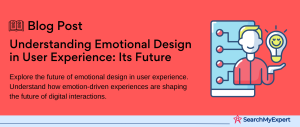Introduction to UX Design
What is UX Design?
User Experience (UX) Design is a multifaceted discipline focused on crafting user-centric products and services. It involves a deep understanding of users’ needs, behaviors, and motivations, and applies this knowledge to design solutions that are not only functional but also enjoyable and accessible. At its core, UX Design seeks to improve the overall experience of a user when interacting with a product, ensuring it is as intuitive, seamless, and engaging as possible.
Differentiating UX from UI and Other Design Disciplines
While often used interchangeably, UX Design and User Interface (UI) Design are distinct disciplines:
- UX Design is about the overall feel of the experience. It encompasses all aspects of the end-user’s interaction with the company, its services, and its products.
- UI Design, on the other hand, is more about the look and layout. It’s the graphical user interface of an application, including buttons, icons, spacing, typography, color schemes, and responsive design.
Beyond UI, UX also differs from other design fields such as graphic design (focused on aesthetics and visual communication) and interaction design (concerned with the interactive elements of a system).
Why UX Design Matters: Its Impact on Business and Users
- Enhanced User Satisfaction:
A well-designed UX can significantly improve the user’s satisfaction with a product, leading to a better overall experience. - Increased User Engagement: UX Design can lead to higher user engagement, encouraging users to interact more with the product or service.
- Boost in Conversion Rates:
Effective UX Design can increase conversion rates, turning visitors into customers more effectively. - Competitive Advantage:
Businesses with a strong focus on UX Design can stand out from competitors, offering a more compelling user experience. - Reduced Development Costs: Investing in UX Design upfront can help identify potential issues early, reducing costly changes later in the development process.
The UX Design Process
The UX Design process is a systematic approach that guides the creation of products that provide meaningful and relevant experiences to users. It involves several key phases, each playing a crucial role in ensuring the final product meets the needs and expectations of its users.
Key Phases of the UX Design Process
- Research:
This phase involves gathering insights about the users and their needs. Techniques include user interviews, surveys, and market analysis. - Ideation: In this phase, designers brainstorm and generate a range of creative ideas and solutions. This often involves sketching, mind mapping, and other creative exercises.
- Prototyping:
Designers create a scaled-down version of the product to test its features and functionality. Prototypes can range from simple sketches to interactive digital models. - Testing:
The prototype is tested with real users to gather feedback. This phase is crucial for understanding user reactions and experiences. - Iteration: Based on feedback from testing, the design is refined and improved. This cycle of testing and iteration continues until the product meets the desired user experience standards.
Understanding User-Centered Design Principles
User-centered design (UCD) is a design philosophy and a process in which the needs, wants, and limitations of end-users are given extensive attention at each stage of the design process. Key principles include:
- Empathy for Users:
Understanding and empathizing with users is fundamental to creating solutions that truly meet their needs. - Inclusivity:
Designing for a diverse range of users, considering different abilities, cultures, and backgrounds. - Feedback and Adaptation:
Continuously seeking user feedback and being willing to adapt the design accordingly. - Usability:
Ensuring the product is intuitive, easy to use, and accessible to as many users as possible.
Tools and Methodologies Used in UX Design
- Wireframing and Prototyping Tools:
Software like Sketch, Adobe XD, and InVision helps in creating wireframes and prototypes. - User Research Tools:
Tools like SurveyMonkey and UserTesting provide platforms for conducting user research and testing. - Design Thinking:
A methodology that provides a solution-based approach to solving problems, widely used in UX design. - Agile Methodology:
Often used in conjunction with UX design, Agile methodology supports a flexible and iterative design process.
Understanding Users in UX Design
A deep understanding of users is crucial in UX Design. It involves exploring their needs, behaviors, and motivations to create products that offer meaningful experiences. This understanding is achieved through various research methods, the creation of user personas, and mapping user journeys.
User Research Methods
- User Interviews:
Conducting one-on-one interviews to gain insights into users’ thoughts, experiences, and preferences. - Surveys:
Utilizing questionnaires to collect data from a larger user base, offering quantitative insights into user preferences and behaviors. - Usability Testing:
Observing users as they interact with a product to identify usability issues and areas for improvement. - Field Studies: Gathering data in the users’ natural environment to understand the context in which a product will be used.
- Analytics Review:
Analyzing data from tools like Google Analytics to understand how users interact with a product online. - A/B Testing:
Comparing two versions of a webpage or app to see which performs better and understand user preferences.
Building User Personas and User Journeys
- User Personas: Semi-fictional characters created to represent different user types. These personas are built on research and help in understanding various users’ needs, experiences, behaviors, and goals.
- User Journeys: Visual or narrative representations of the user’s experience with a product over time and across different channels. They help in understanding how users interact with a product and identify potential friction points.
Identifying User Needs, Pain Points, and Expectations
- Identifying User Needs: This involves understanding what users require from a product to achieve their goals.
- Understanding Pain Points: Recognizing the challenges and frustrations users face while interacting with a product.
- Setting User Expectations:
Understanding what users expect from the product in terms of functionality, performance, and usability.
Information Architecture and Interaction Design in UX
In UX Design, Information Architecture (IA) and Interaction Design (IxD) play pivotal roles in ensuring a product is intuitive, accessible, and pleasant to use. These disciplines focus on organizing information effectively and designing seamless interaction flows, tailored to various platforms and devices.
Organizing Information for Optimal Access and Usability
- Structuring Content: Categorizing and structuring content in a logical and user-friendly manner. This involves creating clear hierarchies and taxonomies.
- Navigation Design: Designing navigation systems that allow users to find information quickly and easily. This includes menus, search functions, and breadcrumbs.
- Labeling Systems:
Developing clear and consistent labels for navigation and information, which helps users understand and use a product more intuitively.
Designing Intuitive Interfaces and Interaction Flows
- Creating Wireframes and Prototypes:
Developing basic layouts and interactive prototypes to visualize the design and test interaction flows. - Consistency in Design: Ensuring consistent use of elements like buttons, icons, and fonts to create a coherent experience.
- Feedback Mechanisms: Implementing clear feedback systems in the interface to guide and inform users during their interactions.
Considerations for Different Platforms and Devices
- Responsive Design:
Ensuring that the interface provides an optimal viewing experience across a range of devices, including desktops, tablets, and smartphones. - Platform-Specific Design:
Adapting the design to suit the conventions and user expectations of different platforms (e.g., web vs. mobile apps). - Accessibility:
Designing interfaces that are accessible to users with disabilities, considering aspects like color contrast, keyboard navigation, and screen reader compatibility.
Visual Design and Usability in UX
Visual design and usability are integral to UX, combining aesthetics with function to create an effective and engaging user experience. This involves applying principles of visual design, typography, color theory, and layout, along with ensuring accessibility for a diverse range of users.
Principles of Visual Design for Effective Communication
- Balance and Alignment:
Creating a visually harmonious interface where elements are well-balanced and aligned. - Hierarchy and Emphasis:
Using size, color, and placement to emphasize key information and guide the user’s attention. - Contrast and Color: Employing contrast and color strategically to highlight important elements and improve readability.
- Consistency: Maintaining a consistent style throughout the interface to reinforce recognizability and ease of use.
- Simplicity: Designing clean, uncluttered interfaces that focus on functionality and reduce cognitive load.
Typography, Color Theory, and Layout for Improved User Experience
- Typography:
Selecting and using typefaces effectively to improve readability and convey the right tone. - Color Theory:
Understanding the psychology of colors and using color palettes that enhance the user experience and accessibility. - Layout:
Organizing content in a logical, easy-to-navigate manner, considering factors like spacing, grouping, and the use of grid systems.
Accessibility Considerations for Diverse Users
- Inclusive Design: Ensuring the design is usable by people with a wide range of abilities and disabilities.
- Readable Text: Using fonts, sizes, and colors that are easy to read for users with visual impairments.
- Color Blindness Considerations:
Choosing color schemes that are perceivable by users with different types of color vision deficiencies. - Screen Reader Compatibility:
Designing interfaces that are compatible with screen readers for users who are blind or have low vision. - Interactive Elements: Make sure that interactive elements are easy to identify and use for all users, including those with motor impairments.
Prototyping and Testing in UX Design
Prototyping and testing are crucial stages in the UX design process. They involve creating models of the product and systematically evaluating these with users to refine and enhance the design. This iterative approach ensures the final product meets user needs and expectations effectively.
Creating Low-Fidelity and High-Fidelity Prototypes to Test Ideas
- Low-Fidelity Prototypes: These are basic and often hand-drawn sketches or wireframes of the product. They are quick to create and useful for initial idea validation and early feedback.
- High-Fidelity Prototypes:
More polished and interactive, these prototypes closely resemble the final product. They are used for more detailed user testing and to evaluate the look, feel, and functionality of a design. - Tools for Prototyping:
Various tools like Sketch, Adobe XD, and InVision are used to create both low and high-fidelity prototypes.
Usability Testing Methods and Conducting User Feedback Sessions
- Moderated Testing:
In-person or remote testing where a moderator guides the user through the prototype and observes their behavior and feedback. - Unmoderated Testing:
Users test the prototype independently, often using software that tracks their interactions and records their feedback. - A/B Testing: Comparing two versions of a design to see which performs better in terms of usability and user preference.
- Heatmaps and Analytics: Using tools that provide visual representations of user interaction data to identify usability issues.
Iterating on Designs Based on User Feedback and Data
- Analyzing Feedback:
Systematically examining user feedback to identify common issues and areas for improvement. - Iterative Design:
Refining and adjusting the design based on user feedback. This might involve several rounds of prototyping and testing. - Data-Driven Decisions: Making informed design decisions based on both qualitative feedback from users and quantitative data from usability tests.
Measuring Success and the Future of UX Design
In the ever-evolving field of UX Design, measuring success and staying abreast of emerging trends and technologies are critical. Additionally, understanding the evolving role of UX designers is essential for adapting to future challenges and opportunities.
Metrics for Measuring the Effectiveness of UX Design
- User Satisfaction:
Surveys and feedback forms can be used to gauge how satisfied users are with a product. - Usability Metrics:
These include task success rate, error rate, and time to complete a task. - Engagement Metrics: Metrics like daily active users, session length, and frequency of use indicate how engaging a product is.
- Conversion Rates: The percentage of users who take a desired action, such as signing up or making a purchase.
- Retention Rates:
How often users return to use the product, indicating long-term value and usability.
Emerging Trends and Technologies in UX Design
- Voice User Interfaces (VUIs):
As voice-assisted devices become more common, designing for voice interaction is an emerging trend. - Augmented Reality (AR) and Virtual Reality (VR): These technologies offer new realms for UX designers to explore immersive experiences.
- Artificial Intelligence (AI) in Design: AI and machine learning are increasingly being used to personalize user experiences and automate design tasks.
- Accessibility and Inclusive Design:
There’s a growing focus on creating designs that are accessible to all users, including those with disabilities.
The Evolving Role of UX Designers in the Future
- Broader Skill Sets: UX designers will need to embrace new technologies and methodologies, expanding their skill sets beyond traditional design.
- Strategic Business Role: UX designers are increasingly playing a key role in strategic business decisions, given their understanding of user needs and behaviors.
- Focus on Ethical Design:
As technology advances, there will be a greater emphasis on ethical considerations in design, like privacy and data security. - Collaboration with AI and Automation:
Designers will need to collaborate with automated systems and AI, using these tools to enhance the design process.
Conclusion
In summary, the world of UX Design is multifaceted and continually evolving, requiring a deep understanding of users, a strategic approach to design, and a keen awareness of emerging trends and technologies. From the initial research and ideation to the final prototyping, testing, and measuring success, each phase of the UX design process plays a vital role in creating products that are not only visually appealing but also highly functional and user-friendly.
The role of UX Designers is expanding, with a growing emphasis on ethical design, strategic business involvement, and adapting to new technologies like AI, AR, and VR. As we look to the future, the importance of UX Design in creating inclusive, engaging, and effective user experiences remains paramount, promising a dynamic and innovative road ahead for designers and users alike.
Redefine digital innovation with UX Design Firms.
Table of Contents
Toggle






